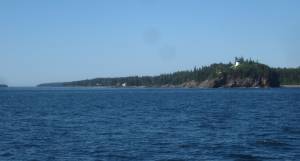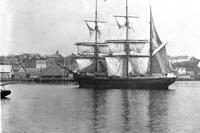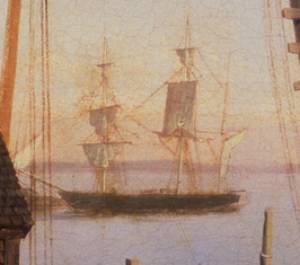An online project under the direction of the CAPE ANN MUSEUM
inv. 399
Approaching Storm, Owl's Head
Schooners before an Approaching Storm off Owl's Head; Schooners Before Approaching Storm; Ships and an Approaching Storm Off Owl's Head, Maine
1860 Oil on canvas 24 x 39 5/8 in. (61 x 100.6 cm) Signed and dated lower right
Private collection
|
Explore catalog entries by keywords view all keywords »
Historical Materials
Below is historical information related to the Lane work above. To see complete information on a subject on the Historical Materials page, click on the subject name (in bold and underlined).
Owls Head is a peninsula that extends into West Penobscot Bay south of Rockland. Owls Head Light also marks the point where the Muscle Ridge Channel opens into West Penobscot Bay. (Muscle may have originally been Mussle).
Owls Head Light guides mariners into the port of Rockland and her ravenous lime kilns. Monroe Island, off Owls Head, has been a landmark for navigators from the age of Champlain, and the lee has provided shelter for mariners throughout the ages, "Owls Head Harbor may well have been the most frequented transient anchorage in the entire Penobscot region until well into the 19th century." "Five Hundred sail have been passing Owl's Head in one day," a mariner writes in the 1850s." Among the many legends of Owls Head was the scalping of 2 Indians by colonial forces led by Capt. Joseph Fox in 1757.
– Mark Honey
References:
Bill Caldwell, Lighthouses of Maine (Portland, ME: Gannett Books, 1986).
Roger F. Duncan, Coastal Maine: A Maritime History (New York: W.W. Norton & Co., 1992).
Charles B. McLane, and Carol Evarts McLane, Islands of the Mid-Maine Coast: Penobscot Bay, vol. 1, rev. ed. (Gardiner, ME: Tilbury House Publishers; in association with the Island Institute, Rockland, ME),120–22.
William Hutchinson Rowe, The Maritime History of Maine: Three Centuries of Shipbuilding & Seafaring (New York: W.W. Norton & Co., 1948).
Letter
Cape Ann Museum Library & Archives, Gloucester, Mass.
Thanks for "View of Owl's Head", a moonlight scene: "Mr. Lane, Dear Sir, when I expressed to you, during your visit to us, the last summer, my admiration of moonlight scenes, I did not for a moment suppose that I should ever become the possessor of one, and that so beautiful as "The View of Owls Head," which you have so kindly, and in so delicate a manner presented to me, and for which, I now beg you to accept my heartfelt thanks, also, be assured, if your pleasure in giving has been half equal to mine in receiving, you have been amply repaid for your kindness, and I alone, am the debtor. . . ."
In the ninteenth century, the term "bark" was applied to a large sailing vessel having three masts, the first two (fore and main) being square-rigged; the third (mizzen), fore-and-aft rigged. The reduced square-rig made the vessel easier and more economical to handle, using a smaller crew. (1)
Barks had significant presence in mid-nineteenth-century America, as indicated by Lane’s depictions of them. Hardly any are to be found in his scenes of major ports, but some do appear in his Cape Ann scenes (see The Fort and Ten Pound Island, Gloucester (Harbor Scene), 1848 (inv. 58), View of Gloucester, 1859 (inv. 91), Gloucester Harbor, 1850s (inv. 391), and Bark "Eastern Star" of Boston, 1853 (inv. 571)), also in views of other small ports and of coastal shipping (see Clipper Ship "Southern Cross" in Boston Harbor, 1851 (inv. 253), Merchantmen Off Boston Harbor, 1853 (inv. 267), Approaching Storm, Owl's Head, 1860 (inv. 399), and Bark "Mary" (inv. 629)).
Brigs, and to a lesser extent ships, were the vessels of choice for Gloucester’s foreign trade in the first half of the nineteenth century. They brought cargos from the West Indies, South America, and Europe, anchoring in the deeper parts of the Inner Harbor while lighters off-loaded the goods and landed them at the wharves in Harbor Cove, by then too shallow for the newer, larger merchant vessels coming into use. (2) By mid-century, barks were gradually replacing brigs and ships, while the trade with Surinam was removed to Boston in 1860. (3)
Some bulk cargos still had to be landed in Gloucester, salt for curing fish being the most important. “Salt barks” brought Tortugas salt from the West Indies, and in the 1870s, Italian salt barks began bringing Trapani salt from Sicily. The importation of salt by sailing ships ended with the outbreak of World War I. (4)
The term barkentine, like the bark, pre-dates the nineteenth century, but in the mid- to late 1800s referred to a large vessel of three masts (or more), with only the fore mast square-rigged, the others being fore-and-aft-rigged. In Lane’s time, the term was little known in the United States, while many other names were coined for the rig. One of these early terms was demi-bark, probably from the French demi-barque, which was applied to a very different kind of vessel. (5) Lane’s depictions of these rigs include a lithograph of the steam demi-bark "Antelope" View of Newburyport, (From Salisbury), 1845 (inv. 499) and at least three depictions of Cunard steamships The "Britannia" Entering Boston Harbor, 1848 (inv. 49), Cunard Steamship Entering Boston Harbor (inv. 197), and Cunard Liner "Britannia", 1842 (inv. 259). (6) None of these subjects typify the barkentine rig as applied to sails-only rigs as they developed in the years after Lane’s death.
– Erik Ronnberg (May, 2015)
References:
1. R[ichard] H[enry] Dana, Jr., The Seaman's Friend (Boston; Thomas Groom & Co., 1841. 13th ed., 1873), 97 and Plate IV with captions; and M.H. Parry, et al., Aak to Zumbra: A Dictionary of the World's Watercraft (Newport News, VA: The Mariners’ Museum, 2000), 43.
2. Alfred Mansfield Brooks, Gloucester Recollected (Gloucester, MA: Peter Smith, 1974), 56, note 10; 67, note 7.
3. James R. Pringle, History of the Town and City of Gloucester (1892. Reprint: Gloucester, MA, 1997), 106–08.
4. Raymond McFarland, A History of the New England Fisheries (Philadelphia: University of Pennsylvania, 1911), 95–96; and Mark Kurlansky, Salt: A World History (New York: Walker & Co., 2002), 419–420.
5. Parry, 44, 167. Dana has neither definition nor illustration of this rig.
6. J[ohn] W. Griffiths, “The Japan and China Propeller Antelope," U.S. Nautical Magazine III (October 1855): 11–17. This article includes an impression of Lane’s lithograph on folded tissue.
Stereograph card
Cape Ann Museum Library & Archive
This view of Gloucester's Inner Harbor shows three square-rigged vessels in the salt trade at anchor. The one at left is a (full-rigged) ship; the other two are barks. By the nature of their cargos, they were known as "salt ships" and "salt barks" respectively. Due to their draft (too deep to unload at wharfside) they were partially unloaded at anchor by "lighters" before being brought to the wharves for final unloading.
– Erik Ronnberg
Also filed under: Historic Photographs » // Salt » // Waterfront, Gloucester »








Commentary
One of Lane’s most dramatic works, this is a masterful depiction of a ship preparing for the approaching storm that is already lashing the distant vessels on the horizon. The ship is becalmed in a flat sea and haloed in an unearthly light while the men run through the rigging furling the sails. Lane’s depiction of the rigging in bright white—like a spider’s web against the black sky—contributes to the sense of the unreality of the vessel, entirely apart from the world around it, bathed in a glorious light. Yet the scene is entirely real—Lane has captured a fleeting moment often seen on the Maine coast in extraordinary detail. The painting is dated 1860; John Wilmerding has noted that in paintings of this period, Lane’s “stark tonal contrasts coincide with the literal storm clouds and civil fires of a nation at war with itself.” Certainly the tranquility and optimism so fundamental to Lane’s work, and by extension the nation, can here be seen to be threatened in an allegorical way. Yet with Lane one can never be sure of the overt statement, his subtlety and fidelity to the moment are so true as to leave further interpretation to the viewer.
– Sam Holdsworth
[+] See More